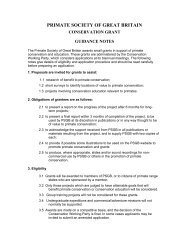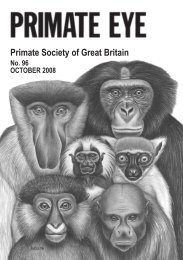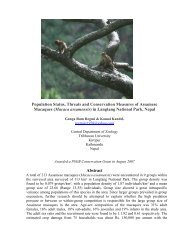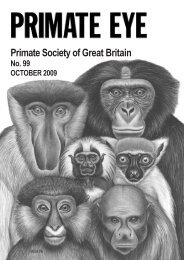2010 Vol 101.pdf (1.63mb) - Primate Society of Great Britain
2010 Vol 101.pdf (1.63mb) - Primate Society of Great Britain
2010 Vol 101.pdf (1.63mb) - Primate Society of Great Britain
You also want an ePaper? Increase the reach of your titles
YUMPU automatically turns print PDFs into web optimized ePapers that Google loves.
Application <strong>of</strong> the comparative method in reconstructing extinct<br />
primate social behaviour<br />
K. Balolia<br />
Department <strong>of</strong> Anthropology, University College London<br />
The comparative method has had some application to date in reconstructing<br />
the social behaviour <strong>of</strong> extinct primates, in that many researchers have used<br />
observed level <strong>of</strong> skeletal dimorphism in extant primates to make inferences<br />
about mating systems <strong>of</strong> extinct taxa. However, in this context, the<br />
comparative method is limited in its application to the reconstruction <strong>of</strong><br />
primate social behaviour in that dimorphism alone is not able to distinguish<br />
between specific types <strong>of</strong> mating behaviour (Plavcan, 2000; J Hum Evol 39,<br />
327-344).<br />
A new approach to the study <strong>of</strong> extinct hominin social behaviour by<br />
Lockwood et al. (2007; Science 318, 1443-1446) showed that Paranthropus<br />
robustus males underwent extended development into adulthood and<br />
matured later than females to attain a high level <strong>of</strong> cranial dimorphism. In<br />
taking this approach, they provided new scope for considering the<br />
relationship between social behaviour and morphology using a comparative<br />
framework. Through measuring overall levels <strong>of</strong> sexual dimorphism<br />
combined with size and shape changes in the adult skull <strong>of</strong> Pan, Gorilla,<br />
Pongo, Hylobates and Papio, I show how this approach, in conjunction with<br />
methodological advances in quantifying cranial morphology, can be used to<br />
investigate the relationship between morphology and intrasexual<br />
relationships in primates. In addition to males showing prolonged growth to<br />
attain full adult size, I consider the suggestion that cranial size and shape<br />
changes occur, which relate to social dominance, both in males and in<br />
females. Associated implications for future attempts to reconstruct extinct<br />
primate social organisation using a comparative framework are discussed.<br />
Digit ratios and social systems in fossil hominids<br />
E. Nelson<br />
School <strong>of</strong> Archaeology, Classics and Egyptology, University <strong>of</strong> Liverpool<br />
Social systems underpin many aspects <strong>of</strong> primate behaviour and predicting<br />
the social systems <strong>of</strong> extinct hominids (great apes) is critical for<br />
understanding human palaeobiology, as well as social and cognitive<br />
evolution. However, predicting social systems from fossils is problematic<br />
due to difficulties in estimating body size dimorphism from fragmentary<br />
remains and, in hominins, low canine size dimorphism. Recent studies have<br />
shown that the second-to-fourth digit length ratio (2D:4D), a putative<br />
biomarker for prenatal androgen effects, co-varies with social systems<br />
across haplorrhines; polygynous species have significantly lower 2D:4D<br />
ratios (high prenatal androgen effects) than pair-bonded species. This study<br />
13






